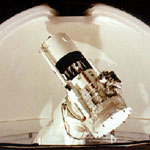
A new planet has been discovered in the Milky Way with the help of a team of Tasmanian astronomers.
The gassy planet is about 1,000 times the size of earth and is located halfway to the centre of the galaxy - about 25,000 light years away.
The Paris Institute for Astrophysics is coordinating the project; four Southern Hemisphere telescopes, including the University of Tasmania's Canopus Observatory, were involved in the discovery.
The university's Stefan Dieters says they used a little-known technique called "micro-lensing" to identify the planet.
"It's the only method around at the moment that can detect earth-mass planets," he said.
"So with this discovery we are now very confident we can detect an earth-mass planet, if we get a little bit of luck."
Professor John Dickey, who leads the Tasmanian team, says the planet appears to be massive - up to 10 times the mass of Jupiter.
"What's special about this event is it was discovered in a way - that is this gravitational lensing method - which could, in principle, turn up earth-like planets as well," he said.
Professor Dickey says there is always an element of luck involved in such discoveries and the team cannot claim all the glory.
"I don't think it's fair to say that one team made the discovery [but] we were an indispensable part," he said.
"Without us, I think it's fair to say that they wouldn't have been able to claim detection of the planet."The original article can be found here
